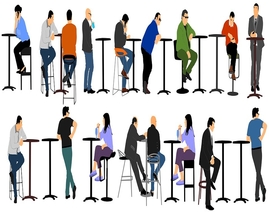Transformation of industry verticals through 5G – Focus and Look Indoors
Now that 5G is here, it is time to up the ante. Many of us (analysts in particular) have been waiting in anticipation to see how all the potential that we saw in 5G is going to start triggering the necessary building blocks that will transform the region and the world. The much anticipated infrastructure – less hyped this time - that will enable a smarter and more connected world promised to drive digital economies for governments, to create new monetization opportunities for businesses and offer a real perceivable difference over 4G for consumers. Has it delivered? Well, not yet. However, there have been some critical changes on the supply side that are seen as positive for the industry. Firstly, there have been changes in terms of who owns the network infrastructure. Sites, especially indoor sites, are no longer solely owned by mobile operators but increasingly owned by tower companies and neutral hosts. In fact, a key milestone in industry collaboration and integration of the telecommunications and real estate industries was achieved in China earlier this month. The Shanghai Lujiazui L+ Mall was launched and will offer a high quality, innovative shopping experience powered by 5G. Services range from shopping assistance, delivery, and destination guidance offered by 5G smart robots to 5G+AI face recognition, 5G+8K HD video, indoor precise navigation and people flow analysis. Secondly, an Open Site Interest Group has been set up. As an industry collaboration initiative, it seeks to enable scaled construction of 5G through use of a site resource sharing platform and site construction standards. Thirdly, industry is increasingly accelerating applications through standardization. This will impact customer experience and give the application economy a boost. Lastly, for the first time since 2G, a spirit of enablement is taking shape across the region and around the world. Bringing it all together through industry collaboration is now more feasible than ever. Although not immediately apparent, the combination of these changes can potentially trigger drastic change and the start of a whole new wave of growth mobile operators. So, will it happen? Possibly. To make it reality, industry needs to focus and look indoors. According to a survey conducted at the 5th Annual Asia Pacific Spectrum Management Conference held in Kuala Lumpur in March 2019, 79% of respondents said that they will rate their mobile operator according to the indoor network quality that they experience. Within the survey, Malaysian respondents were more critical of their mobile operator with 88% of respondents claiming indoor system quality as important to them. Malaysians also showed that they were more supportive of Digital Indoor Systems (DIS) than their global counterparts. An overwhelming 93% of Malaysians agreed that DIS availability was important. These statistics represent the changing needs on the demand side across the region that needs to be addressed. With 80% of network traffic now originating from indoors, it is not hard to see that indoor use cases will become a key driver of 5G networks. As the number of 5G launches increase in number, mobile data usage will increase exponentially alongside new applications such as Internet of Things (IoT), virtual reality (VR), augmented reality (AR), 8K live video streaming and location-based services (LBS). All of which will primarily take place indoors. This means that improving customer experience indoors to monetize 5G will become a priority and of utmost importance. This coupled with users increasingly becoming critical of their mobile operators when it comes to the indoor environment require that mobile operators focus on indoors for the next wave of growth. 5G has the potential to transform industry verticals through 5G indoor connectivity but experts in the industry expect certain key verticals will experience stronger growth than others. Interestingly, the survey also found that a key driver for spend on DIS is solving pain points for users. Ecosystem partners interviewed go further to say that once DIS in place, new applications can be monetized which will be a factor that can drive further spend in DIS. Smart in the Philippines and AIS in Thailand bring a different perspective to light. Their implementations of DIS highlight the need for successful brand maintenance as a critical survival factor within an increasingly competitive landscape, not just for mobile operators but for businesses in general. A key success factor for DIS would be for mobile operators to focus on key verticals where there will be stronger growth and a clearer value proposition for 5G indoor connectivity. Verticals such as retail, media and entertainment, tourism and hospitality, and industrial manufacturing are some examples of the more promising key verticals. o Within retail, shopping malls around the world are transforming into shopping experience centers. They are now providing value add network based services such as AR/VR game services and heat maps to drive retail spend. o Within media and entertainment, 5G stadiums seek to offer unique, thrilling experiences for audiences using AR to draw the crowds in. News spreads quickly of the use of an AR firebreathing wyvern on opening day 2019 at Munhak Baseball Stadium in South Korea. o Within tourism and hospitality, smart hotel concepts are paving the way for the industry to soar to greater heights in customer experience. The InterContinental Shenzhen in China recently initiated creating the industry’s first end-to-end 5G network that will offers guests innovative, luxury experience. o Within industrial manufacturing, increasing cost pressure is driving the need for high network availability to support use of augmented remote service assistance and real-time and historical data for predictive analysis to improve operational efficiency and productivity. Given the advantages of DIS over the conventional Distributed Antenna System (DAS), mobile operators worldwide have already begun the transition from DAS to DIS. To date, the most notable progress has been in China with its achievement of about 80% penetration for new indoor system deployments. The nation as a whole has achieved consensus on what is need to progress in terms of indoor network coverage and regulators have developed performance test criteria for 5G indoor scenarios. This soon to be ubiquitous indoor experience will facilitate the many applications soon to entice China’s millennials that have high spending power. Wechat’s 1 million mini programs1 are only an indicator of what might be facilitated within China’s new indoor environment. Regionally, a common theme across the case studies of mobile operators implementing DIS show that mobile operators are looking for cost effective, future-proof solutions (e.g. 5G-ready) that can be deployed quickly. For example, HKT in Hong Kong implemented DIS to reduce CAPEX as lead 1 million-mini-programs mobile operator while sharing the 5G-ready solution and providing high quality mobile data service to subscribers. Turkcell in Turkey leveraged on DIS for the shorter construction time and 5Greadiness and Sichuan Mobile in China deployed DIS in office buildings, shopping malls and hospitals to refresh and improve existing indoor application coverage. In conclusion, conventional economics dictate that the supply side needs to be optimized to address changes on the demand side. There is no doubt that indoor use cases will become a key driver of 5G networks and correspondingly users will make increasing demands on their mobile operator when it comes to the indoor environment. Focus needs to shift to transforming indoors for DIS to enable 5G and on specific key verticals for the next wave of growth to happen. 5G is here, it is time for transformation of the indoors environment, especially in Malaysia.
You May Also Like

Install These Free Security Tools Now!
Have you heard of intrusion detection systems? Also known as IDS, this software is often used to det...

Crowdfunding drives unprecedented efficiency
Crowdfunding has become the center of attention in the field of financing. It is also an increasingl...

Everything As a Service
Transition from Capex economy to Opex Economy World is in a transition from Macro to Micro. Granula...

IoT in Malaysia – 2019 Predictions
The year 2014 is when Malaysians started to Google the term “IoT” and ever since, the hy...

The business case for 5G
As of 2018 ,33 MNOs have been involved in 5G trials within Asia Pacific, accounting for 44% of 77 tr...

A New Face On Digital Transformation: Engagement Innovation
Whether we believe it or not we are in the fourth industrial revolution – The Digital Revoluti...

Technology & Competitive Data Analysis More Money – More Competition; everyone wins
Technology & Competition – More Money, Better Deal for Consumers & Companies – H...

Anatomy of Fintechs that’s redefining Financial services business models.
On a weekend in 2013 during monsoon I invited my friend and his family for a dinner at my place. It ...

Blockchain Taxation
World has paid a heavy price for trust, transparency, controls and accountability. Globally there i...

Why Is CDR / CDNR So Important?
Addressing the Fundamental Deficiency in Today’s Mainstream Cyber Security Strategies From Det...

CIO Business leadership - shifting from tech to business leadership
CIOs are no longer technocrats, they are business enablers and crucial part of organisation. CIOs sh...

Ideas and Opinions | 5G as an Enabler of Smart Cities
When 5G comes to mind these days, we think of “is this REALLY it?” and “have we re...

Lessons in Machine Learning
More organizations are using machine learning for competitive reasons, but their results are mixed. ...

Digital Indoor System: Critical Infrastructure for Digital Economic Transformation
Digital Indoor System: Critical Infrastructure for Digital Economic Transformation Developme...

The Changing DNA of the CIO CIO as Business Enabler
The idea that the role of the CIO has now gone beyond technology and innovation related issues, and ...

Today's Digital Miners
Today's Digital Miners I guess by now everyone of us who have read an article or two on digital...

Digital Transformation Readiness Test for Banks
Digital Transformation Readiness Test for Banks The questions banks need to try to answer to test ...

What is Machine Learning
What is Machine Learning? According to Tom Mitchell, a professor at Carnegie Mellon University has d...

Humanize Technology - back to the basics of serving human needs, humanly
Humanize Technology - back to the basics of serving human needs, humanly The subjects of Digital Tr...

Creating the foundation for Sustainable Innovation
Creating the foundation for Sustainable Innovation In 2011, Marc Andreessen famously proclaimed tha...

About Tech Data Diversity And Inclusion
About Tech Data Diversity And Inclusion I am excited about attending the Hispanic IT Executive Coun...

Digital Transformation: Customer Centricity & Intimacy
Digital Transformation: Customer Centricity & Intimacy It was inspiring listening to IMD Profess...

Is Industry 5.0 putting humans back in the center
Industry 4.0 focused on the machines. Is Industry 5.0 putting humans back in the center? I was on a...

Importance of IT Resilience
Importance of IT Resilience Disclaimer: The posting written here is solely of my own comment and ...

Implementing a SaaS Solution – The 3 Major Technical Challenges
So when are you planning to implement a SaaS (Software as a Service) solution? Very soon, if not alr...

So you want an #Innovation Hub?
Innovation, Design Thinking, Digital, Disruption, Agile, Transformation - these are new buzz words t...

The Unsung Hero; The Data Scientist
It is quite likely you are wondering ‘what on earth’ am I on - for cooking up such a tit...

How POC projects made me a better Project Manager
How did I get here? Project Management is a tough job. We need to keep a track on budgets, timeline...

How Data and AI can help in COVID-19 crisis
Since the first report of coronavirus (COVID-19) in Wuhan, China, it has spread to at least 100 othe...

Building thriving business partnerships with Open API
Apple and Google recently collaborated to assist in enabling contact tracing and reducing the spread...

The Future of Indoors with Digital Indoor Systems
Digital Transformation, 5G, and COVID-19 have triggered further growth in indoor traffic Digital tr...

Seizing Opportunities in the ICT Sector
The Increased Pace of Digital Transformation Automation, digitalisation, artificial intelligence (A...

CoVID19, Digital, ML
CoVid19 hit us and has now created the “new Normal” in terms WFH, Video conferences, bal...

Do we really need CEOs, CFOs, and CIOs?
Why CMOs and CTOs are all you need to succeed in today's world This is my first article in a se...

Cinématographe by the Lumière Brothers & History of AI
The Lumière brothers, Auguste and Louis, French inventors and the pioneer manufacturers...

Avenues To Expedite The Incorporation Of 5G Into Industry
5G has been launched in Asia Pacific. South Korea, China, the Philippines and other countries have b...

4G/5G Fixed Wireless Access: A Critical Revenue Growth Engine
In studying key success factors of solutions, it can almost always be shown that the underlying conc...

Big Data Machine Learning IoT and PI
In the era of the Internet of Things (IoT), an enormous amount of sensing devices collect and genera...

Asia’s Plan To Leverage 5G Is Missing A Regional Strategy
The day the world’s first commercial 5G services promised a “great leap” is still ...

Learning from #COVID19…Would remote working be the new normal?
Musings of a Technology Evangelist In the past few months, we have all learnt many new terms&hellip...

Principles of Sustainable Cybersecurity
In past few years the annual rate of cybersecurity breaches has almost been doubled, and as a result...

Data Governance a key element for Digital Transformation
For the last few years, corporate environment, used to speak and hear lots of financial/management t...

Seven Traits of a Millennial CEO
With a staff strength and annual turnover in the order of billions and trillions respectively, Chris...

What is a Pass Key and Is Now the Time To Adopt Them?
What is a Pass Key and Is Now the Time To Adopt Them? There has been recent news about a mass...








Quah Mei Lee
Associate Director with the Frost & Sullivan ICT
Quah Mei Lee is an Associate Director with the Frost & Sullivan ICT practice. She leads Mobile & Wireless Research for Asia-Pacific and focuses on telecoms and payments strategy. Supported by her expert team, she drives thought leadership in telecoms and payments strategy and mobile digital services research.